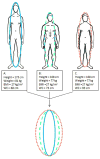Relationships between body roundness with body fat and visceral adipose tissue emerging from a new geometrical model
- PMID: 23519954
- PMCID: PMC3692604
- DOI: 10.1002/oby.20408
Relationships between body roundness with body fat and visceral adipose tissue emerging from a new geometrical model
Abstract
Objective: To develop a new geometrical index that combines height, waist circumference (WC), and hip circumference (HC) and relate this index to total and visceral body fat.
Design and methods: Subject data were pooled from three databases that contained demographic, anthropometric, dual energy X-ray absorptiometry (DXA) measured fat mass, and magnetic resonance imaging measured visceral adipose tissue (VAT) volume. Two elliptical models of the human body were developed. Body roundness was calculated from the model using a well-established constant arising from the theory. Regression models based on eccentricity and other variables were used to predict %body fat and %VAT.
Results: A body roundness index (BRI) was derived to quantify the individual body shape in a height-independent manner. Body roundness slightly improved predictions of %body fat and %VAT compared to the traditional metrics of body mass index (BMI), WC, or HC. On this basis, healthy body roundness ranges were established. An automated graphical program simulating study results was placed at http://www.pbrc.edu/bodyroundness.
Conclusion: BRI, a new shape measure, is a predictor of %body fat and %VAT and can be applied as a visual tool for health status evaluations.
Copyright © 2013 The Obesity Society.
Figures



References
-
- Cai L, Lubitz J, Flegal KM, Pamuk ER. The predicted effects of chronic obesity in middle age on medicare costs and mortality. Med Care. 2010;48(6):510–7. - PubMed
-
- Fontaine KR, Redden DT, Wang C, Westfall AO, Allison DB. Years of life lost due to obesity. JAMA. 2003;289(2):187–93. - PubMed
-
- Cowie CC, Rust KF, Byrd-Holt DD, Eberhardt MS, Flegal KM, Engelgau MM, et al. Prevalence of diabetes and impaired fasting glucose in adults in the U.S. population: National Health And Nutrition Examination Survey 1999–2002. Diabetes Care. 2006;29(6):1263–8. - PubMed
-
- Li Z, Bowerman S, Heber D. Health ramifications of the obesity epidemic. Surg Clin North Am. 2005;85(4):681–701. v. - PubMed
Publication types
MeSH terms
Grants and funding
LinkOut - more resources
Full Text Sources
Other Literature Sources

